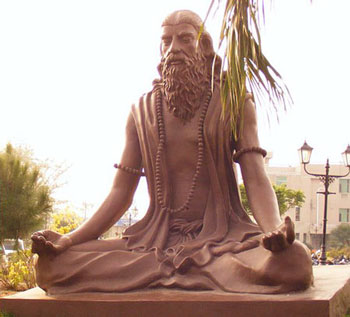by Michael Mamas | Tuesday, May 30, 2017 | Spiritual Evolution, Vedic Science |
- Vedanta is not really a philosophy. It is a state (level) of consciousness. In the state of Vedanta, one spontaneously sees through the veil of illusion. It is as if everything is lightly etched on the face of Oneness. It is not an attitude or philosophy. It is a physiological level of human evolution. If we’re not careful, studying Vedanta becomes an attempt to put Unboundedness in the boundaries of a box.
- Humans evolve through the elevation of their level of consciousness.
- Deep inside, everybody is one with the source of everything, the essence of all knowledge. This is why so many think they are enlightened when they first learn about Vedanta. The knowledge resonates with that deep inner knowing. Whether or not it is fully integrated with all levels of their being, is quite another matter. Enlightenment means integration.
- Trying to live a limited understanding of Vedanta as a behavior or philosophical overlay in daily life is epidemic, yet tragic. It is attempting to conform to a distorted notion. Enlightenment is not even about conformity. It’s about becoming integrated with the level of life that transcends conformity. Functioning harmoniously with the world of conformity is quite different from losing your Self to those conformities.
- People often think enlightenment looks a certain way, but it does not. Just as every snowflake is unique, every individual is unique.
- There are ever-increasing levels of understanding, but they all parallel. When someone understands Vedanta on a superficial level, it parallels deeper understandings. However, they think they get it. Echoes of Truth, perceived as Truth, hold Truth at bay. This is called the I-get-it Syndrome.
- There are an unlimited number of awakenings along the way. People have an awakening, think they are enlightened, think they ‘get it,’ and go out and teach. Tragic… well intended, but it leads people astray.
- People conform to superficial notions of enlightenment and decide they are enlightened. For example, it’s easy to hold hands and sway and get enchanted with the notion that we are all one. But ultimately, Oneness is something much deeper.
- Every level of understanding dictates a different world view. Once a particular level of understanding is identified with, people decide they ‘get it.’ This precludes them from going deeper. In the Vedic tradition, there is the notion of “Neti, Neti, Neti”: not that, not that, not that. Of course, people hear that notion and decide they ‘get it.” They decide their level of understanding is as deep as it goes.
- Non-attachment is not on the surface. It is deep inside. In the state of non-attachment (freedom from desire), we still can prefer salted caramel ice-cream over vanilla. The full range of emotions is still lived. Lord Rama fell to the ground and sobbed when his wife, Sita, was kidnapped. Yet he was living in the state of non-attachment.
- Some people think they can behave in a Vedantic manner. Behavior is superficial. Living Vedanta does not show on the surface. It is deeper than that.
- Doing the Vedanta cha-cha is a very common syndrome. People think they get Vedanta, enlightenment. But they are only clinging to echoes of Truth.
- It is not about intellectual understanding. It is a state of physiology.
- Every level of understanding is a self-sustaining, circular, impervious world of self-justification. People get stuck in a particular level of understanding. If you talk to them, they ‘get’ everything you say. If you say to them, “Enlightenment is deeper,” they say, “Right.”
- Attaining enlightenment is a highly elusive process, referred to as “traversing the razors edge” or “passing through the eye of the needle.”
- We live in Kali Yuga (the age of ignorance): Ignore-ance. Ignoring what lies deeper. Most ‘teachers’ read a few books, meditate a bit, decide they get it, and go out and teach.
- People sometimes say with pride something like: “I have been meditating for 30 years.” I respond by saying, “If you must measure, evolution is not measured in years, it is measured in lifetimes.”
- It is not comfortable to be in a room full of people identified with (indoctrinated into) a shared level of understanding/indoctrination. You will be judged if you do not conform.
- People call their ‘teacher’ someone who is more indoctrinated into (better at) their indoctrination than they are.

© Michael Mamas. All rights reserved.
by Michael Mamas | Tuesday, February 7, 2017 | Clarifying Confusion, Spiritual Evolution, The Veda |
 I’ve been asked to comment on the meaning behind on the story of Lila in the Yoga Vasistha. My favorite book on the Yoga Vasistha is called The Concise Yoga Vasistha by Swami Venkatesananda. You can access the ebook version of the Concise Yoga Vasistha here.
I’ve been asked to comment on the meaning behind on the story of Lila in the Yoga Vasistha. My favorite book on the Yoga Vasistha is called The Concise Yoga Vasistha by Swami Venkatesananda. You can access the ebook version of the Concise Yoga Vasistha here.
Now to the explanation: Imagine a deck of cards sitting upon a table, each card neatly stacked, one on top of another. Though there is a sequence to the order of the cards (top card, one below it, another below that, etc.), they are all superimposed on each other. This can be compared to the sequentiality of the Veda itself. Modern physicists tell us that within the unified field (the Transcendent, i.e., pure Consciousness), there is no time, nor is there space. Space and time are an attribute of relative existence. ‘Before’ the manifestation of existence, there was no space and no time. Within the Transcendent, sequentiality and simultaneity are one and the same. Also, the notion of separation inherent in space collapses down to the unification of all that is.
The universe manifesting can be compared to spreading a deck of cards out across the table, across the face of space and time. Now imagine that each card represents a lifetime with its own place in space (location in the universe) as well as its own place in the sequentiality of time.
In the story of Lila, Sarasvati freed Lila from the bondage of one lifetime, as well as the notion that lifetimes take place through the sequentiality of time. Within the Absolute (the Transcendent, the Veda), all lifetimes, and in fact all that is, exist simultaneously within Consciousness. Consciousness is the Transcendent. Everything exists within that one Consciousness. Consciousness equals ‘Is-ness.’
Divine Intellect (Sarasvati) can be compared to the structure and order of a piano keyboard. Lila (Divine Play) dances upon that keyboard. This is why Sarasvati holds a Veena (musical instrument) in her hands. It is appropriate then that Sarasvati (Divine Intellect) taught this nature and structure of existence to Lila (Divine Play), thusly revealing Lila’s own true nature to her.
Sarasvati, by giving Lila the experience of simultaneity of all events, frees Lila from bondage to the limitation of awareness. She thusly frees her and enlightens her.
© Michael Mamas. All rights reserved.
by Michael Mamas | Saturday, February 4, 2017 | Spiritual Evolution |
 Hear not just with the ears but with the whole body.
Hear not just with the ears but with the whole body.
Touch not just with the fingertips but with the whole body.
See not just with the eyes but with the whole body.
Taste not just with the tongue but with the whole body.
Smell not just with the nose but with the whole body.
Consciousness is Consciousness
The body is Intellect.
The mind is gap between Consciousness and the Intellect, the dance between the Breath of Consciousness and the multiplicity Consciousness births. Knower is Consciousness. Known is Intellect. Process of Knowing is mind.
When the Knower is not lost to the Known, the mind is Cosmic Mind.
Then the Knowner, the Known, and the Process of Knowing are seen as one and the same… the Samhita of Rishi, Devata, and Chhandas.
When the Knower is lost to the Known, the mind is individual awareness.
When the Knower is lost to the Known, karma is born and the mind becomes the dance between Prana (the Breath of Consciousness) and Karma.
© Michael Mamas. All rights reserved.
by Michael Mamas | Wednesday, January 18, 2017 | Clarifying Confusion, Spiritual Evolution |
 It is commonly believed that knowledge is the result of observations of the outer world. It is the foundation of the scientific method. However, if we just give it a little thought, we realize that the observations are not the knowledge. It is how we put those observations together within our own minds that is the source of knowledge. Knowledge then is an inner experience, not an outer observation. What we observe matters little if we do not find understanding of those observations within ourselves. Knowledge comes from within.
It is commonly believed that knowledge is the result of observations of the outer world. It is the foundation of the scientific method. However, if we just give it a little thought, we realize that the observations are not the knowledge. It is how we put those observations together within our own minds that is the source of knowledge. Knowledge then is an inner experience, not an outer observation. What we observe matters little if we do not find understanding of those observations within ourselves. Knowledge comes from within.
The methodology of evolving our ability to become a person of greater knowledge is not usually known. It is the cultivation of inner awareness. The most powerful tool to accomplish this is proper meditation. There are various forms of meditation, but very few cultivate evolution. Rather, most control or condition the mind and/or heart to function in a particular manner. A meditation that cultivates evolution allows and facilitates a natural blossoming of awareness.
The potential of such cultivation goes far beyond the imagination of most. All knowledge is contained within. It is merely a matter of cultivating ones ability to tap more and more fully into that level of evolution.
© Michael Mamas. All rights reserved.
by Michael Mamas | Saturday, January 7, 2017 | Spiritual Evolution |
Discernment is the integration of one’s mind with the heart of one’s being… the soul of one’s existence… the essence of one’s life. It is found within your self… within the heart of your being, your essence. The essence of one’s life is the underlying common denominator to all of life, to everyone and everything in existence. To sense it is called common sense… sensing that which underlies and is our common denominator. The refinement of common sense is called wisdom. The path of wisdom is the path of discernment is the inner path… the ultimate journey.

© Michael Mamas. All rights reserved.


 I’ve been asked to comment on the meaning behind on the story of Lila in the Yoga Vasistha. My favorite book on the Yoga Vasistha is called The Concise Yoga Vasistha by Swami Venkatesananda. You can access the ebook version of the Concise Yoga Vasistha
I’ve been asked to comment on the meaning behind on the story of Lila in the Yoga Vasistha. My favorite book on the Yoga Vasistha is called The Concise Yoga Vasistha by Swami Venkatesananda. You can access the ebook version of the Concise Yoga Vasistha  Hear not just with the ears but with the whole body.
Hear not just with the ears but with the whole body. It is commonly believed that knowledge is the result of observations of the outer world. It is the foundation of the scientific method. However, if we just give it a little thought, we realize that the observations are not the knowledge. It is how we put those observations together within our own minds that is the source of knowledge. Knowledge then is an inner experience, not an outer observation. What we observe matters little if we do not find understanding of those observations within ourselves. Knowledge comes from within.
It is commonly believed that knowledge is the result of observations of the outer world. It is the foundation of the scientific method. However, if we just give it a little thought, we realize that the observations are not the knowledge. It is how we put those observations together within our own minds that is the source of knowledge. Knowledge then is an inner experience, not an outer observation. What we observe matters little if we do not find understanding of those observations within ourselves. Knowledge comes from within.
